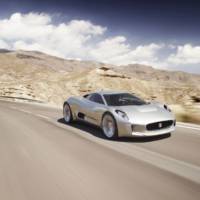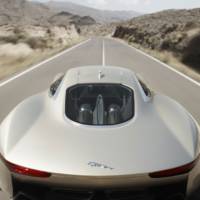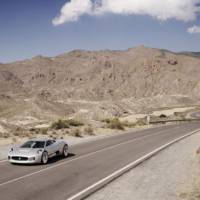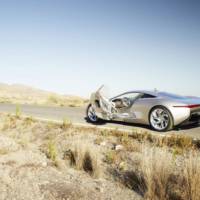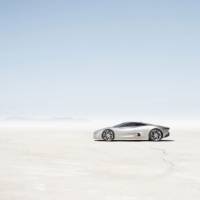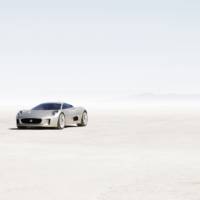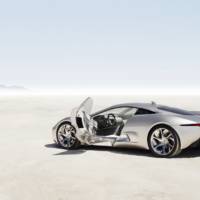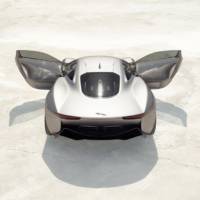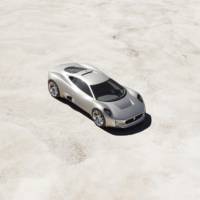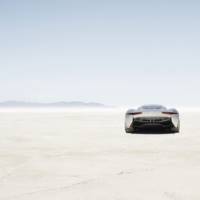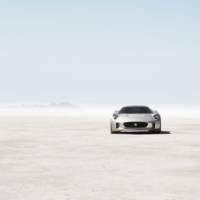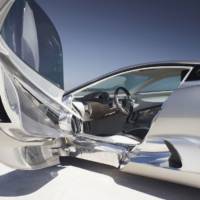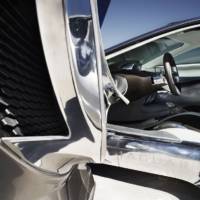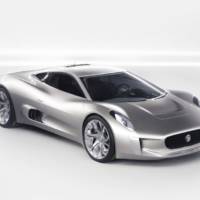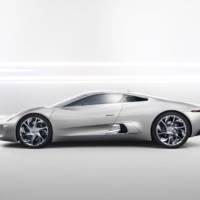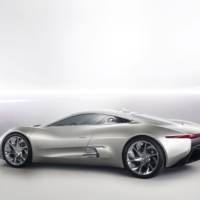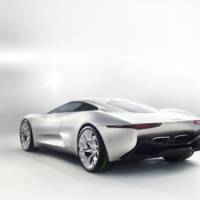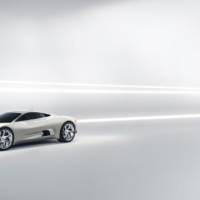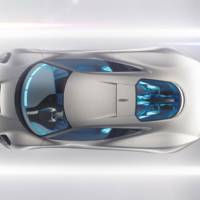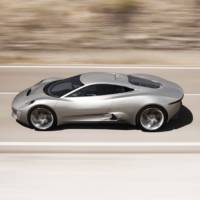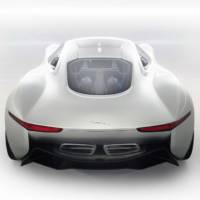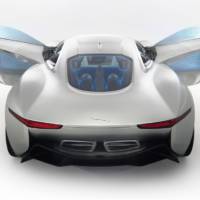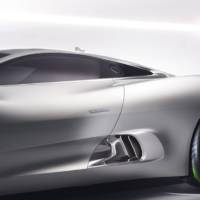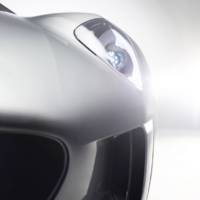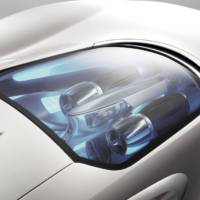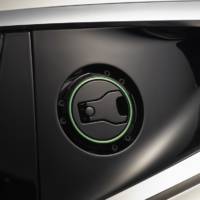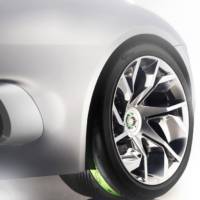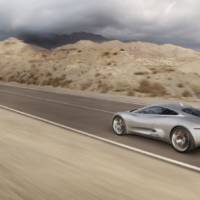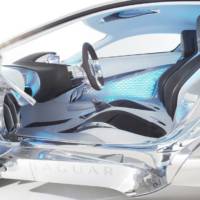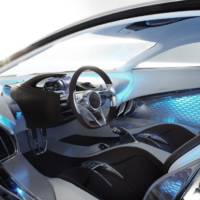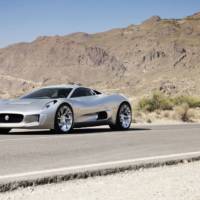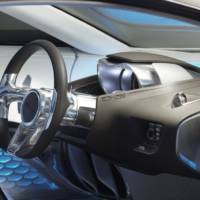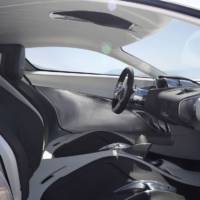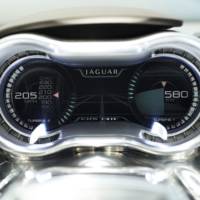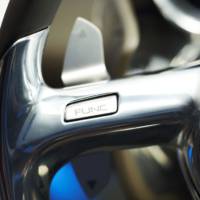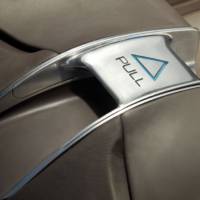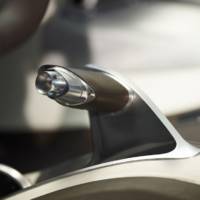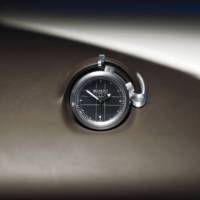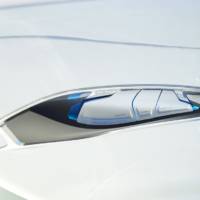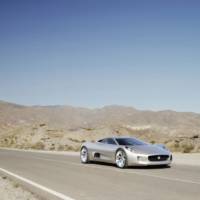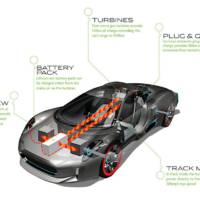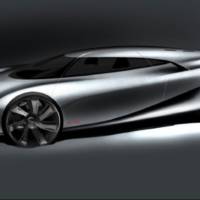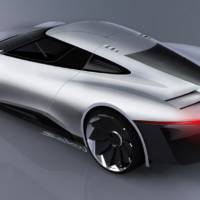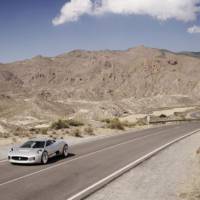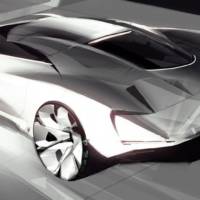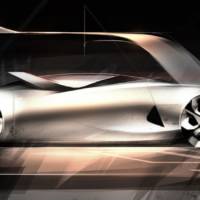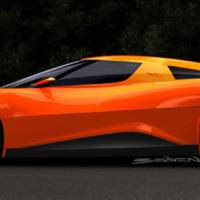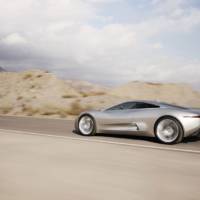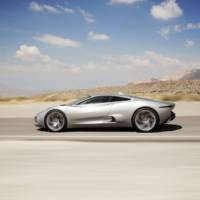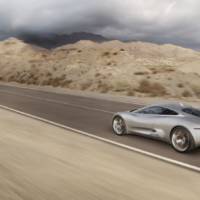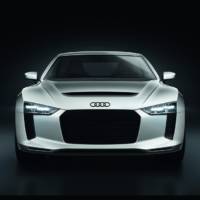The British company has pull the wraps off the Jaguar C-X75 Concept just as the 2010 Paris Motor Show is about to begin.
Powered by two small micro gas turbine engines providing 140 kW, which can run on LPG, diesel, biofuel or natural gas, plus four electric motors ( delivering 145 kW) linked to a lithium ion battery pack, the Jaguar C-X75 Concept can reach speeds of up to 330 Km/h (205 mph).
When accelerating from 0 to 100 Km/h the Jaguar C-X75 Concept needs 3.4 seconds, 5.5 seconds from 0 to 161 Km/h (0 to 100 mph) in 5.5 seconds and from 0 to 300 Km/h (0 to 186 mph) in 15.7 seconds.
When running on battery power alone, the Jaguar C-X75 Concept can cover 68 miles while the turbines act like range extenders and enable it to cover much longer distances, of 900 Km (560 miles).
The Jaguar C-X75 Concept weights 1,35 tons and measures 4.6 meters in length.
Jaguar press release :
"Performance through innovation has always been a Jaguar hallmark. From the beginning, cars such as the C-Type and D-Type pioneered aluminum construction, aerodynamic design, racing monocoques and disc brakes. The Jaguar C-X75 demonstrates that the company is still leading the field in automotive design and technology." – Dr Ralf Speth, Chief Executive Officer, Jaguar Land Rover
The Jaguar C-X75 concept is both a celebration of 75 years of iconic Jaguar design and a look into the future of automotive technology. Designed as a range-extended electric two-seater supercar, it explores the outer limits of both performance and sustainability. With plug-in capability the car can achieve a zero tailpipe emissions range of 110km (68 miles) – three times round Paris’s Péripherique – when running under battery power alone, plus a potential top speed of 330kph (205mph) and blistering acceleration. The car demonstrates that it is possible to retain Jaguar’s core values of performance, design and luxury using technology that will make environmentally responsible performance and electric vehicles a practical proposition.
The aim was to produce not only the most innovative but also one of the most beautiful Jaguars ever; one which hints at an exciting evolution of the marque’s award-winning design language while paying homage to some of its most admired cars of years gone by. Advanced design features such as a ground-breaking propulsion system and active aerodynamics allow for an elegantly simple fuselage section that remains stable at very high speeds.
"The Jaguar C-X75 is a tribute to the people who shaped the iconic Jaguars that are revered to this day. By making it an innovative test-bed for the technologies of tomorrow, it also ensures that our reputation for engineering excellence will continue for another 75 years and beyond."
– Mike O’Driscoll, Managing Director, Jaguar Cars
The Jaguar C-X75’s 580kW (778bhp) propulsion system combines powerful 145kW (195bhp) electric motors at each wheel for outstanding performance. At the center of the car sit state-of-the-art, mid-mounted micro gas-turbines. These can either generate 140kW (188bhp) to charge the batteries and extend the range of the car to a remarkable 900km (560 miles) – enough to drive from London to Berlin on a single tank – or when in Track mode provide supplementary power directly to the electric motors. The four electric motors provide torque-vectored, all-wheel drive traction and grip, essential in a car that produces 580kW (778bhp) and 1600Nm (1180lb ft) of torque.
The car’s interior is equally impressive, with the driver and passenger seated ahead of a sealed airbox that houses the micro gas-turbines. The seats are fixed to the bulkhead as in a single-seater racing car, and air to feed the turbines passes smoothly around them via channels in the structure of the body. With the seats anchored in place, the steering wheel, controls, main binnacle and pedal box all adjust towards the driver.
Dramatic theater lighting is activated as the driver approaches the car; phosphor blue electro-luminescent wire lights illuminate the perimeter of the cabin and the turbines. When the car is started, additional blue LED lighting gently floods the door and bulkhead speaker cavities, highlighting the car’s lightweight construction. Bespoke interior materials include cream and grey leathers, polished and vapor-blasted aluminum and a soft-feel textured neoprene.
A new interface for the driver has also been created for the Jaguar C-X75 using high-resolution TFT screens. Building on Jaguar’s 10-year expertise in touchscreen technology, the Jaguar Co-Pilot display in the center console supports the driver in extracting the full potential of the Jaguar C-X75 by seamlessly managing information.
The Jaguar C-X75 – At a Glance
DESIGN – A celebration of 75 years of beautiful, fast Jaguars which points the way to a new design language
PERFORMANCE – 0-100kph (62mph) in 3.4 seconds, top speed of 330kph (205mph) and 80-145kph (50-90mph) in just 2.3 seconds
PROPULSION SYSTEM – A Range-Extended Electric Vehicle (RE-EV) using a unique combination of electric motors and micro gas-turbines to increase its range to 900km (560 miles)
EMISSIONS – A zero tailpipe emissions range of 110km (68 miles) while running solely on battery power
SUSTAINABILITY – By capitalizing on its plug-in charge capability the Jaguar C-X75 will produce just 28 grams of CO2 per kilometer on the EU test cycle
CONSTRUCTION – Jaguar’s advanced lightweight aluminum construction techniques provide great weight-saving and economy benefits. Additionally, up to 50 percent of the metal content is recycled
ACTIVE AERODYNAMICS – Drag coefficient of 0.32Cd and active downforce created through the use of an underbody Venturi
THEATER – A dramatic entrance to the car is created by striking electro-luminescent wire lighting which alters to enhance the driving experience
UNIQUE USER INTERFACE – The touchscreen Jaguar Co-Pilot interface manages the information workload by predicting the needs of the driver
BESPOKE MATERIALS – Interior seamlessly blends traditional, hand-tailored leathers with textured neoprene panels and two different aluminum finishes
Jaguar C-X75 Design – At a Glance
CELEBRATING 75 YEARS – Entirely forward looking, the Jaguar C-X75 marks three-quarters of a century of iconic Jaguar design
FUTURE FOCUS – The current XF, XK and XJ have already won plaudits for their design and the Jaguar C-X75 points the way to an evolving future style language
DESIGN-LED SOLUTIONS – An elegant demonstration of how Jaguar’s core values – performance, design, luxury – will be delivered in the future
DESIGN PURITY – The simple tubular fuselage exterior shape of the Jaguar C-X75 has been achieved without sacrificing aerodynamic efficiency
AIRFLOWED INTERIOR – The simple, flowing curves of the interior are inspired by the movement of air to the turbines
DRIVER-FOCUS – The Jaguar C-X75 tailors itself perfectly to the driver through an adjustable instrument binnacle, steering wheel and pedal box
INTERIOR THEATER – Unique interior electro-luminescent wire lighting welcomes the driver to the car and alters its output according to driving mode
CABIN TECHNOLOGY – An innovative nano-technology sound system offers active noise-cancelling and an exclusive clock is wound by the acceleration and braking forces of the car
UNIQUE MATERIALS – Bespoke interior materials combining Jaguar-commissioned leathers, metal micromesh panels, soft-feel textured neoprene and a mixture of polished and vapor-blasted aluminum surfaces
75 Years of Jaguar Design
For 75 years, Jaguar has been responsible for some of the most iconic road and racing car designs ever seen. The roll call of names will be familiar to all: XK120, C-Type, D-Type, XJ13, E-Type, XJ220. To that list can now be added the Jaguar C-X75, which celebrates three-quarters of a century of beautiful, fast Jaguars by being the fastest and perhaps most beautiful concept of them all.
Jaguar has an award-winning portfolio of designs in its current range of XK, XF and XJ models and the Jaguar C-X75 reinforces the marque’s design-led approach to product development. Created under the guidance of Design Director Ian Callum, the concept points the way towards an even more emotive design language which combines beautiful contemporary styling with world-class research and engineering.
Aficionados will identify elements from Jaguars of the past in the Jaguar C-X75 but the intention was not to look back but forward. The Jaguar C-X75’s designers stayed true to the long-held Jaguar design philosophy of natural, flowing lines and simple, elegant forms. Where inspiration from the past was found was in the innovative engineering and functional design elements of cars like the 1950s C-Type and D-Type racers and unique 1966 XJ13 Le Mans prototype – a car described by Callum as, "possibly the most beautiful Jaguar ever made."
Just as the XJ13 acted a test-bed for a new engine, the Jaguar C-X75 offers similarly positive and inspiring potential solutions to the challenges posed by environmental concerns. Performance cars have always aimed for efficiencies in terms of weight, agility and dynamics, all of which also benefit economy. Using previously unseen combinations of technology, the Jaguar C-X75 supercar provides a glimpse into the future of Jaguar and its commitment to producing beautiful, fast cars powered by sustainable means.
Exterior Design
"The Jaguar C-X75 is everything a Jaguar should be. It possesses remarkable poise and grace yet at the same time has the excitement and potency of a true supercar. You could argue this is as close to a pure art form as a concept car can get and we believe it is a worthy homage to 75 years of iconic Jaguar design."
– Ian Callum, Design Director, Jaguar Cars
Finished in Jetstream Silver, the Jaguar C-X75’s beautiful proportions, sculpted lines and powerful stance have been created, in the words of Julian Thomson, Assistant Design Director and head of the Jaguar Advanced Design Studio, to "pull at the same emotional heartstrings as classic Jaguars such as the D-Type and XJ13 racers."
The Jaguar C-X75 borrows more than simply elegant looks from previous classic designs, however, for those cars were equally respected for the purity of their engineering. Jaguar C-X75 has been created to indicate the future for luxury carmakers such as Jaguar. It shows that it is possible to retain core brand values while offering zero emissions motoring for much of the time, as well as range-extending technologies that will make electric vehicles significantly more practical.
Aerodynamic Purity
Shorter, slimmer and lower than the current crop of supercars, its exterior design is about pure performance with a simple central fuselage surrounded by prominent wheelarches. Thanks to the packaging efficiencies provided by the absence of a conventional piston engine, the car’s designers had maximum freedom in placing the mechanical components and creating the most elegant engineering package available. Consequently the car has the most perfect proportions and sense of balance possible with a compact cabin placed centrally between the dramatic wheel arches. The lines of the supercar are purposeful and agile, suggesting a sense of movement and poise.
Aerodynamics are a key factor in designing a supercar capable of accelerating to speeds in excess of 320kph (200mph). Yet, as Thomson explains, the designers weren’t prepared to sacrifice the car’s beauty when it came to creating downforce and stability at high speeds:
"Because we want this to be one of the most beautiful Jaguars ever, we took a much more elegant approach to the Jaguar C-X75’s aerodynamics and exploited the benefits of having an electrically-powered drivetrain."
Using an underbody Venturi and directional exhaust gas control kept the car as sleek, compact and low as possible while still generating immense amounts of grip and downforce. Indeed, the movement of air itself was one of the principle drivers behind many of the design cues that were incorporated into the bodywork. Principal designer Matt Beavan reveals how the airflow into the turbines helped to shape the surfaces of the car itself:
"We wanted to emphasize how the air makes its way not just over the car but is also channeled into the rear airbox. When operating at 80,000rpm, each gas-turbine requires 25,000 liters of air a minute which means we need a series of carefully honed intakes."
The two beautifully sculpted sill-mounted aluminum intakes have a striking two-tone finish, with polished inner surfaces emphasizing their functionality. Above them sit two further intakes that feed cold air to a separate turbine cooling system.
The turbine theme is also echoed in the stunning alloy wheels which appear to have been cut from a single block of aluminum with a spoke design inspired by the fan blades of the engines themselves. The tires have been custom-made by Pirelli with an asymmetric tread pattern and bold green F1-style wear indicator running the circumference of the tire.
Forward-hinged doors are opened using Jaguar Sense touch technology, raising outwards and upwards for excellent cabin access. To maintain the purity of the side profile, the designers replaced conventional door mirrors with cameras housed in a tailfin which is a miniaturized echo of that of the D-Type – images are displayed on screens inside the cabin. Behind the doors, fuel fillers sit either side of the cockpit – reminiscent of the twin-tank system on the original XJ6 – which on the Jaguar C-X75 access respectively the fuel tank for the turbines and the plug-in battery charging point.
The eye is then drawn towards the sealed compartment which houses the twin micro gas-turbines and the beautiful structural bracing that supports them. Exposed through the rear window – much like with the XJ13 – the remarkable turbines are showcased by their elegant aluminum housing and Texalium woven fabric lining the engine bay.
The compact packaging of the turbines allowed the designers further freedom at the rear of the car, which is shaped like the trailing edge of an aircraft wing. This is both functional – incorporating the Venturi aerofoil – and beautiful with a sharp swage line and dramatic, slim full-LED rear lights.
Interior
Jaguar has a long tradition of using the finest materials to create a cosseting and luxurious cabin that allows the driver to concentrate on the experience of driving, culminating in the award-winning interior of the current XJ. With the Jaguar C-X75, Jaguar has blended beautiful leathers with innovative materials and finishes to create an elegantly tailored and driver-focused cabin that is defined and inspired by the technology that powers this sustainable supercar.
The twin micro-turbines provided great inspiration when designing the interior architecture. The turbines themselves require vast amounts of air and driver and passenger are placed in the calm centre of this storm. The soft shapes and surface changes of the cabin reflect the movement of air, unseen and unheard by those inside, within the channels surrounding it.
The seats are fixed into the rear bulkhead that forms part of the airbox feeding the turbines, integrating driver and passenger not only into the structure but also the function of the car. A beautifully formed aluminum spar directs air into the turbines which are supported by spiral-shaped cast brackets that appear to flow directly from the seats’ headrests.
Driver-focused cabin
While Jaguar cabins have always been calm, comfortable sanctuaries for passengers, their focus has remained centered on the driver. The Jaguar C-X75 takes this commitment to its logical conclusion by placing the driver as close as possible to the centre of the car. As a result the cabin tailors itself perfectly and uncompromisingly to the driver. A rocker switch on the steering wheel brings the wheel and instrument panel towards the driver, revealing a beautifully polished aluminum surround to the binnacle. The pedal box is likewise fully adjustable to create the perfect driving position.
The sense of occasion and driver experience engendered by the Jaguar C-X75 is unsurpassed. Electro-luminescent micro-wires and LEDs use vibrant light to create two very different environments within the cockpit, making it feel incredibly dramatic and highlighting the car’s width. As the driver approaches the car, a bright ring of phosphor blue wire lighting outlines the extreme plan shape of the car by leading the eye around the monocoque tub and into the turbine chamber.
When the driver enters, the electro-luminescent wire illumination is replaced by LEDs emitting a phosphor blue light that dims as the occupants settle themselves into the cockpit. This gentle illumination from inside the doors and bulkhead cavities creates a translucency inspired by lightweight aircraft structures and exposes the Bowers & Wilkins nano-speaker panels behind the micromesh. Additional LEDs behind the dashboard and underneath the turbines make both installations appear to ‘float’ inside the structure of the car.
The car is started using a switch mounted in the aircraft-inspired overhead control panel. Twin needles indicating turbine functionality sweep dramatically around the edge of the main dials and back to rest.
When driven in Track mode the cabin changes character once again – taking inspiration from fighter aircraft in combat mode. The Jaguar Co-Pilot touchscreen system switches to stealth and all ambient cabin lighting fades to minimize driver distraction. The electro-luminescent wire now forms blades of blue light which outline the driver’s seat and controls.
The lighting however is not the only feature which lends a sense of theatre and uniqueness to the experience of piloting the Jaguar C-X75. The gear-selector is modeled on a fighter jet’s throttle control and includes a manual override for the turbines, allowing them to run continuously for maximum charge.
Unique Materials
A unique, sustainable performance supercar, the Jaguar C-X75 utilizes materials that reflect its design and engineering ideals. A luxurious cream Ceramic semi-aniline leather was chosen for the dashboard to complement the purity of the polished aluminum. In contrast, a more technical full-aniline Storm Grey leather was used on the seats. The leathers themselves have their own sustainability story, having been sourced from Scottish company Bridge of Weir, one of the most modern and environmentally efficient leather producers in the world.
To highlight the main driver interfaces, the instrument binnacle, gear selector and certain areas of the steering wheel are covered in a soft-feel textured neoprene. This malleable material allowed the designers to sculpt soft, flowing surfaces that encase the technical hardware. The leading edges of the instrument binnacle have a satin smooth finish while further back the material is covered in grains subtly shaped like the traditional Jaguar ‘lozenge’ logo.
Reflecting the polished working surfaces on the exterior of the car, the air-conditioning vents also feature a dual finish although this time it is reversed, with mirror-finished external surfaces and vapor-blasted matt interior. Inside the vents can be found an aluminum honeycomb structure similar to that used in aircraft construction.
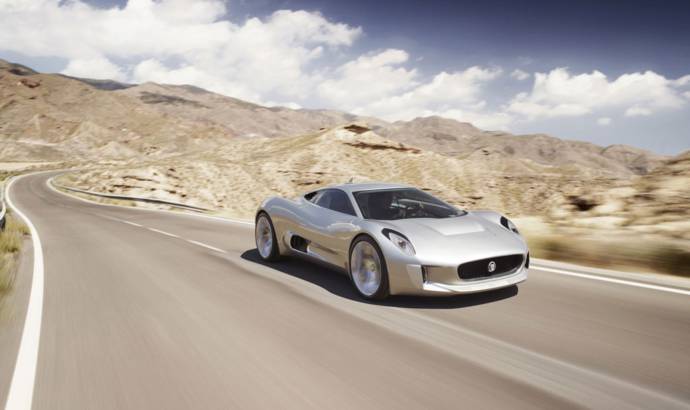
29 Sep 2010
0

